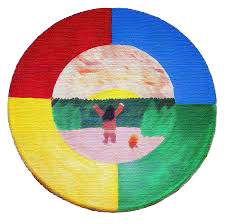An Update
I am back working with the girls of the Stardale Women's Group this year. We are developing a performance piece titled "The Road" which came about following a conversation between Helen McPhaden and myself this summer. We had gotten together, as usual at Caffe Beano, shortly after the findings of the Commission into the Inquiry of Missing and Indigenous Women. I was reminded of the Highway of Tears, about which a friend of mine wrote a play a number of years ago. I thought the idea of the road, as metaphor of our girls' lives, as well as that of the history, present and future of their First Nations could lead to an interesting and compelling presentation. And so off we go!
This is the third time I have worked with the girls. (By "the girls," I mean the participants of the Stardale program generally. The girls I first worked with six years ago have moved on and are young women now, though there is some continuity year to year. None of the girls I worked with the first time out are in this year's batch.)
Helen hired me six years ago to create some kind of performance piece examining the issue of youth suicide in First Nations communities. It will probably come as no surprise that the instances of suicide among First Nations youth are markedly higher than in any other community in Canada.
Stardale had been invited to present this piece (whatever it would be) to about 400 policy makers and "experts" in the area at a conference in Edmonton. The room was booked, the audience (an influential one at that) would be there. The only thing we didn't have was something to present and that's where I came in. Helen invited me for coffee at Caffe Beano.
"So I need you to get the girls' thoughts on suicide and from there write a presentation piece that we can do," she likely said.
"OK . . .how many girls are there?"
"25."
"25. Gee, that's a lot. Do they have any acting experience?"
"No."
"How old are they?"
"Between ten and seventeen."
A wiser man than I might have walked away, but I could sense Helen's sincerity and who knows, if we could come up with something that might shine some greater awareness on this situation, maybe even help save a few lives down the road, then it would obviously be worth while.
It was tough sledding, at first. The girls didn't know me. There are very few men involved with Stardale, and what am I if not a white man? A very tall one at that. Some of them really didn't know what to make of me.
Somehow, we got something down on paper. I tried as far as possible to use only the words the girls gave me. We hired a good young theatre maker named Genevieve Pare to direct the piece, and thanks to her good efforts we were able to put together a final script. It was called Committing.
Twenty-five First Nations girls on stage at the same time, right there in flesh and blood, speaking to an audience of over four hundred people who had been talking about them and their problems all morning - it was a very strong statement.
We have been invited to present this piece on many occasions since that day in Edmonton six years ago. A few years ago, Helen and I and several of the girls got together and pared it down to be presented by 3 girls and a narrator (i.e., me).
As I write these words, we are preparing, while in the middle of a snow storm, to present this smaller version of the script at the "Orange Shirt Day" activities in Calgary, "an event that started in 2013 . . . designed to educate and promote awareness about the Indian residential school system and the impact this system had on indigenous communities for more than a century in Canada, and still does today."
Their Motto: Every child matters.
That might well be the motto of the Stardale groups as well.
Eugenius 1 and the story journey begins.

